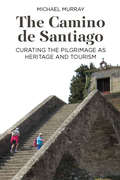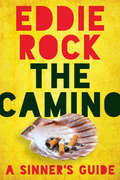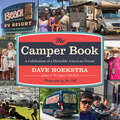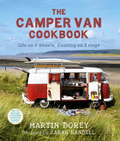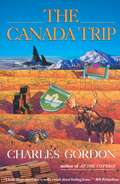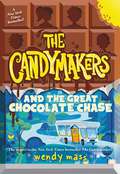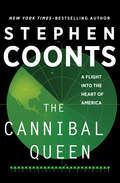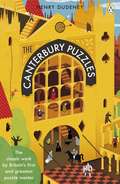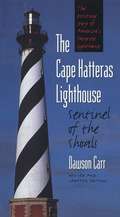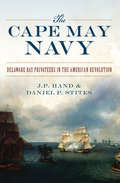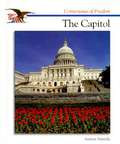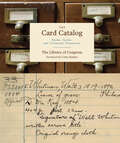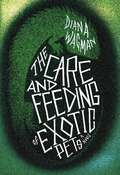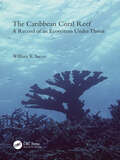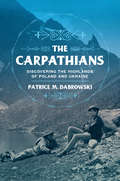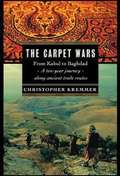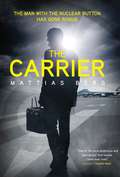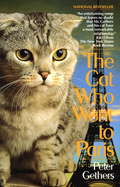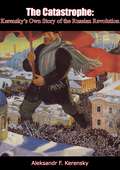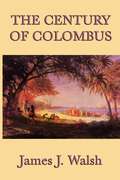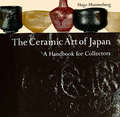- Table View
- List View
The Camino de Santiago: Curating the Pilgrimage as Heritage and Tourism
by Michael MurrayPilgrimage, as a global activity linked to the sacred, speaks to the special significance of persons, places and events. This book relates these sentiments to the curatorship of the Camino de Santiago that comprises a lattice of European pilgrimage itineraries converging at Santiago de Compostela in northwest Spain. The detailed analysis focuses on the management of pilgrimage settings as heritage and tourism linked to the shrine of Saint James and gives particular attention to investment guidelines, land use planning regulations, environmental stewardship, information dissemination and museology.
The Camino: A Sinner's Guide
by Eddie RockAspiring travel writer Eddie Rock has hit hard times. Drowning in a midlife crisis of fear and debt, he looks for a second chance.A night of debauchery with a sexy hippy girl on the west coast of Ireland and A fortuitous encounter with false a prophet in Artic Canada triggers his story with warnings in the not-so-distant-futureAn unfortunate brush with the law, and an unforgettable stag party in Amsterdam set the tone for Eddie's timeless European misadventure. Following in the footsteps of countless saints and sinners before him, Rock travels the well-trodden road to Santiago de Compostela in search of enlightenment, salvation, and forgiveness, with a full cast of strange and interesting characters, spectacular places and plenty of wine.Eddie Rock's book is honest, entertaining, a warts-and-all romp as he takes us on a long walk of alcoholic indiscretions, more brushes with the law and accidental applications of deep heat, all the while providing an entertaining commentary of his surroundings and never taking himself too seriously. It makes for a refreshing change from the usual run of Camino stories, treating the whole thing as some reverential sacred cow!
The Camper Book: A Celebration of a Moveable American Dream
by Dave Hoekstra Jon Sall Jeff DanielsThe Camper Book will captivate all those who dream of waving good-bye to the rat race from the window of their own moveable home, be it a camper, RV, travel trailer, camper van, or tiny camper. Not just for placid retirees anymore, camper culture has sprung up among simplicity-seeking millennials, retro-loving "glampers," sports and movie stars, aging hippies, contract workers, "road-schoolers," and others. Award-winning journalist Dave Hoekstra hit the road in his own custom camper van, named Bluebird, to explore the history, culture, subcultures, and future of camper life. Traveling and talking his way through US campsites, RV parks, landmarks, and communities, Hoekstra draws out revealing stories from all walks of life—from Americans who are downsizing material goods while upsizing spiritual pursuits to RV enthusiasts such as Grammy-winning singer-songwriter John Prine and Chicago Cubs manager Joe Maddon. A modern-day Studs Terkel, Hoekstra provides a delightful mix of oral history, in-depth reporting, and practical information, while photographer Jon Sall's beautiful color photographs illuminate the unique people, places, and rigs that typify camper life.
The Camper Van Cookbook: Life on 4 wheels, Cooking on 2 rings
by Martin Dorey Sarah RandellSay goodbye to roughing it. And hello to a new kind of freedom.With over 80 fabulously tasty recipes you can cook on just two rings and a few barbeque feasts and camp fire crackers, this is the dashboard bible for anyone who ever dreamed of hitting the road at the wheel of a classic VW camper.From finding and cooking your own food to passing muster with the surfing set, THE CAMPER VAN COOKBOOK will show you how to make the most of every single moment on the road.
The Canada Trip
by Charles Gordon“We are back from three months on the highways of Canada, driving 24,863 kilometres, which is 15,539 miles to you old-timers. ” Clearly, after this beginning,The Canada Tripis not going to be a conventional travel guide. Nor is it a journalistic dissection of the mood of the land, because “the country has been analysed to death. ” Instead, Charles Gordon keeps what he calls Inner Journalist in check to give us a record of how a typical traveller sees the country, moseying along in the family car. This makes the book not so much a “Whither Canada?” as a “Whither the washroom?” book, and we are all grateful for it. It started out as a simple idea. Gordon and his wife, Nancy (also known, to her slight irritation, as the Business Manager), the drive across Canada. Starting from Ottawa they drove east through Quebec (“Lac St-Jean is where everybody votes separatist and nobody speaks English and we are making good time and what is this trip about but being spontaneous, right? – so left we go”), through New Brunswick, P. E. I. , Nova Scotia, and Newfoundland, where they learned about “soap for the moose. ” From St. John’s they headed west on a different route through the Maritimes to Montreal, Toronto, and Lake of the Woods (scene of the famous cottage inAt the Cottage). Then it was west along what used to be called the CPR route (with memorable side trips to places like Sharon Butala’s Saskatchewan ranch, immortalised inThe Perfection of Morning) all the way to Vancouver and Victoria. Then, via Prince Rupert, they followed the Yellowhead Trail back through Edmonton and Saskatoon, hitting Flin Flon and Northern Ontario on the way home. They had a wonderful time, rambling around without an agenda, arguing whether today’s view (the Gaspé coast, or the Cabot Trail, or Lake Superior, or Banff, or Long Beach) deserved a place on their Top Ten list. Another list soon developed – the small towns they somehow managed to get lost in – and because Charles Gordon is male and thus unable to stop and ask for directions, many interesting miles were added in this way. Further sacrifices were made by Nancy “for the book,” including a visit to a Regina casino, but she drew the line at the West Edmonton Mall submarine. As well as these family dynamics we meet many Gordon friends and relatives, while memories of Charles Gordon’s namesake and grandfather, the writer known as Ralph Connor, lend special meaning to encounters in Glengarry County, Winnipeg, and Canmore. If you insist on looking for conventional travel guide advice (“Eat here. Stay there”) this book has some interesting twists. In downtown Fraser Lake, B. C. , for instance, Nancy gets carried away and asks about the house white wine. … “‘It doesn't really have a name,’ the waitress replies. ‘It comes in a big white box. Everybody likes it. ’ Nancy tastes it and she likes it too. Wait’ll the big-shot wine stewards in T. O. hear this. ” Besides learning to look for wine in a big white box the alert reader will find where to ask for a Denver as opposed to a Western sandwich, and learn about the Thunder Bay delicacy known to one and all as a Persian. Ranging from moose to chipmunks, from a cool jazz festival to even cooler icebergs, and from the Prestige Motel to the Chateau Lake Louise, this book is a highly personal look at a country well worth visiting, witty and affectionate, a fact that its own citizens tend to overlook. As Charles Gordon, the perfect companion, puts it in his final paragraph, “What does Canada need, you ask, to enter the twenty-first century? More passing lanes. More ferries. Reading la
The Candymakers and the Great Chocolate Chase (Candymakers)
by Wendy MassIt has been a few months since the Harmonicandy was chosen as the winner of the nationwide candymaking contest. Forever changed by the experience, Logan, Miles, Philip, and Daisy have returned to their regular lives. But when presented with the chance to go on tour to promote the new candy, they each have very different reasons for hitting the road. The stakes are a lot higher than they thought, however, and a decades-old secret is revealed. In this action-packed adventure, the four friends embark on a journey full of hidden treasures, imaginary worlds, rivers of light, a map of awe, a sky of many colors, and one very small cat who thinks he's a dog.And candy.LOTS and LOTS of candy.They've already learned to trust one another. Now they'll have to trust themselves in order to face what lies ahead and save what really matters.
The Cannibal Queen: A Flight Into the Heart of America
by Stephen CoontsThe New York Times–bestselling icon of the techno-aviation thriller takes to the skies in this memoir of a great American adventure in an open-cockpit biplane. It was a bird&’s-eye view of America—and the trip of a lifetime for author Stephen Coonts and his fourteen-year-old son. But even for Coonts, who had clocked 1,600 hours as a naval aviator and was the recipient of the Distinguished Flying Cross commendation, this was a first. He&’d be flying closer to the earth than he ever had before. His big yellow wood-and-canvas bird was the Cannibal Queen, a Stearman open-cockpit biplane built in 1942. Destined for the scrap yard, it was rescued and restored for what Coonts would call his &“Stearman summer.&” On a clear June afternoon in 1991, Coonts and his son took off to see the country the same way the barnstormers flew their Jennys: with a map and a compass. Coonts followed highways, railroad lines, back roads, mountains, rivers, and landmarks. For the next three months, seeing old friends and meeting new ones, he touched down on the diverse landscapes of each of the forty-eight contiguous states to record the stories of the American countryside, its spirited people, and its rich history. Soaring from big cities to the heartland, experiencing everything from Bourbon Street jazz and small-town barbershop quartets to greasy spoons and backyard barbeques, the author of Flight of the Intruder and The Art of War captures not only the singular thrill of biplane aviation, but a nostalgia for the simple pleasures of an America thought lost and forgotten. Stephen Coonts found it, and in The Cannibal Queen he shares every exultant moment. This ebook features an illustrated biography of Stephen Coonts, including rare photos from the author&’s personal collection.
The Canterbury Puzzles
by Henry DudeneyFor the mastermind who has what it takes to solve the tricky conundrums from Britain's first and greatest puzzle master.---------------------------------------Solve the puzzle of The Mystery of Ravensdene Park . . . trace the route of the butler, the gamekeeper and the two anonymous guests and the key to the mystery will reveal itself.---------------------------------------Decipher the riddle of The Frogs' Ring for The Merry Monks of Riddlewell . . . ---------------------------------------At The Squire's Christmas Puzzle Party ascertain just how many kisses had been given Under the Mistletoe Bough . . . ---------------------------------------First published in 1907, Dudeney's The Canterbury Puzzles is a classic of the genre, based on characters from Chaucer's Tales. The book contains 114 puzzles suitable for young enthusiasts, recreational mathematicians and veteran puzzlers alike. As challenging today as it was over a century ago, this ingenious book will provide hours-worth of puzzles to keep your brain alert."Regular exercise is supposed to be as necessary for the brain as for the body. Many of us are very apt to suffer from mental cobwebs, and there is nothing equal to the solving of puzzles for sweeping them away." - Henry Dudeney (1847-1930)
The Cape Hatteras Lighthouse
by Dawson CarrSince 1871 the Cape Hatteras lighthouse has been a welcome sight for sailors entering the treacherous region off North Carolina's Outer Banks known as the Graveyard of the Atlantic. At 208 feet high, it is the tallest lighthouse in the country and one of the state's most famous landmarks. Through the years, it has withstood the ravages of both humans and nature, weathering numerous violent storms and two wars. But perhaps the gravest threat the structure faced in recent history was the erosion of several hundred yards of beach that once stood between it and the ocean. As powerful tides and rising sea levels increasingly endangered the lighthouse's future, North Carolinians debated fiercely over how best to save it, eventually deciding on a controversial plan to move the beacon inland to safety. First published by UNC Press in 1991, this book tells the story of the noble lighthouse from its earliest history to the present day. In this new edition, Dawson Carr details the recent relocation of the treasured landmark. For now, it seems, North Carolinians have succeeded in protecting their lighthouse, as it has protected them for over a century.
The Cape May Navy: Delaware Bay Privateers in the American Revolution
by J.P. Hand Daniel P. StitesThe Delaware Bay during the Revolutionary War was vital for trade and home to a host of armed conflicts between British vessels and American privateers. Cape May County captains in their light, fast vessels captured dozens of British merchant ships off the Atlantic coast. At the Battle of Delaware Bay, Lieutenant Joshua Barney aboard the Hyder Ally overcame massive odds and defeated the British warship General Monk. Colonel Elijah Hand, local hero of the skirmish at Quinton's Bridge, took his military talents to the seas, where he dueled with Tory privateers. Still in his twenties, Yelverton Taylor captured the Triton with hundreds of Hessian soldiers on board. Authors James P. Hand and Daniel P. Stites chart the exciting history of the Cape May Navy in the War for Independence.
The Capitol (Cornerstones of Freedom)
by Andrew SantellaThe history of the United States Capitol Building.
The Car Trip (Sound Out Chapter Books - Set B-1)
by Matt SimsRoy sends a postcard each day to his mom telling about what he sees on his trip with his dad.
The Card Catalog: Books, Cards, and Literary Treasures
by The Library of CongressFrom the archives of the Library of Congress: “An irresistible treasury for book and library lovers.” —Booklist (starred review)The Library of Congress brings book lovers an enriching tribute to the power of the written word and to the history of our most beloved books. Featuring more than two hundred full-color images of original catalog cards, first edition book covers, and photographs from the library’s magnificent archives, this collection is a visual celebration of the rarely seen treasures in one of the world’s most famous libraries and the brilliant catalog system that has kept it organized for hundreds of years. Packed with engaging facts on literary classics—from Ulysses to The Cat in the Hat to Shakespeare’s First Folio to The Catcher in the Rye—this is an ode to the enduring magic and importance of books.“The Card Catalog is many things: a lucid overview of the history of bibliographic practices, a paean to the Library of Congress, a memento of the cherished card catalogs of yore, and an illustrated collection of bookish trivia . . . . The illustrations are amazing: luscious reproductions of dozens of cards, lists, covers, title pages, and other images guaranteed to bring a wistful gleam to the book nerd’s eye.” —The Washington Post
The Care and Feeding of Exotic Pets
by Diana WagmanWinnie Parker, mother to an angst-ridden teenage daughter and ex-wife to a successful game show host who left her for a twenty-something contestant, begins a normal day in her hum-drum existence by dropping her car off at the repair shop. After accepting what she believes is a ride to pick up her rental car, Winnie realizes too late that she's been kidnapped.What follows is a riveting psychological game of cat and mouse set in the kidnapper's tropically heated house-kept that way for Cookie, a menacing seven-foot long Iguana headquartered in the kitchen. While desperately seeking to escape-which leads to several violent clashes with her increasingly unstable kidnapper-Winnie also tries to understand why she was taken captive. Is her kidnapper merely seeking a ransom or does he have something more sinister in mind? Does he know that Winnie's mother is an Oscar-winning actress? Or did he connect her with Jonathan, her famous ex-husband? When the truth reveals itself, Winnie is not only forced to fight for her life, but must also protect the lives of those she loves from the kidnapper's deranged master plan.An engrossing, darkly humorous, edge-of-your-seat story, The Care and Feeding of Exotic Pets explores the dynamic between kidnapper and kidnapped, bizarre reptile lore, and the absurdity of the celebrity lifestyle.Diana Wagman is the author of the novels Bump, Spontaneous-which won the PEN Center USA Award for Fiction-and Skin Deep. She is also a contributing writer to the Los Angeles Times.
The Caribbean Coral Reef: A Record of an Ecosystem Under Threat
by William K. SaccoThis book is a visual tour of Caribbean coral reefs between 1968 and 1978. They are the world’s second largest coral reef community and the most threatened. The Caribbean Coral Reef: A Record of an Ecosystem Under Threat offers a priceless historical record made by a photographer who set out to document the major reef species when those reefs were at their prime. Today, coral reefs are under threat as never before and, sadly, most of what is shown in the book's photographs is now gone forever. It is only by comparing the images in this book with what we see now that we are able to fully recognize what we have lost. With its stunning photography and precise, accurate scientific information, this book offers students of coral reefs a wealth of information about this rich, fragile ecosystem. It is also written accessibly for non-academic visitors to the Caribbean reef or anyone interested in the earth’s creatures. Many of the invertebrates will be unfamiliar to most people, and the author reveals fascinating insights into these otherworldly creatures and their lifestyles. Enjoy this field guide to the reefs that were, and savor the beauty of this vanishing environment and its organisms.
The Carpathians: Discovering the Highlands of Poland and Ukraine (NIU Series in Slavic, East European, and Eurasian Studies)
by Patrice M. DabrowskiIn The Carpathians, Patrice M. Dabrowski narrates how three highland ranges of the mountain system found in present-day Poland, Slovakia, and Ukraine were discovered for a broader regional public. This is a story of how the Tatras, Eastern Carpathians, and Bieszczady Mountains went from being terra incognita to becoming the popular tourist destinations they are today. It is a story of the encounter of Polish and Ukrainian lowlanders with the wild, sublime highlands and with the indigenous highlanders—Górale, Hutsuls, Boikos, and Lemkos—and how these peoples were incorporated into a national narrative as the territories were transformed into a native/national landscape.The set of microhistories in this book occur from about 1860 to 1980, a time in which nations and states concerned themselves with the "frontier at the edge." Discoverers not only became enthralled with what were perceived as their own highlands but also availed themselves of the mountains as places to work out answers to the burning questions of the day. Each discovery led to a surge in mountain tourism and interest in the mountains and their indigenous highlanders.Although these mountains, essentially a continuation of the Alps, are Central and Eastern Europe's most prominent physical feature, politically they are peripheral. The Carpathians is the first book to deal with the northern slopes in such a way, showing how these discoveries had a direct impact on the various nation-building, state-building, and modernization projects. Dabrowski's history incorporates a unique blend of environmental history, borderlands studies, and the history of tourism and leisure.
The Carpet Wars: A Ten-Year Journey along Ancient Trade Routes
by Christopher KremmerApart from oil, rugs are the Muslim world's best-known commodity. While rugs are found in most Western homes, the story of religious, political, & tribal strife behind their creation is virtually unknown. Here, Kremmer chronicles his fascinating 10-year journey along the ancient carpet trade routes that run through the world's most misunderstood & volatile regions -- Afghanistan, Iran, Iraq, India, Pakistan, & the former Soviet republics of Central Asia. He takes readers into a world where even the simplest motif on a rug can be filled with religious, tribal, & political significance, & he offers a personal, vivid, & revealing look at Islam's human face, wracked by turmoil but sustained by friendship, industry, & humor.
The Carrier
by Mattias BergThe man with the nuclear briefcase has gone rogue - Mission Impossible meets the Hunt for Red October "What should a thriller do to rise above the ranks of the clichéd? It does no harm to demonstrate some intelligence and (if possible) an engagement with serious issues - but no polemics. Thankfully, Mattias Berg's The Carrier hits those targets squarely" Barry Forshaw, Financial Times"Enjoyable, ingenious . . . packed with fascinatingly arcane nuclear facts" Myles McWeeney, Irish IndependentErasmus Levine has a job like no other He travels with the President of the United States at all times, and holds in his hands the power to obliterate life as we know it. He is the man with the nuclear briefcase, part of a crack team of top-secret operatives established after 9/11, led by a man codenamed Edelweiss. But not even Edelweiss is party to the identity of their ultimate authority, known only as Alpha.Erasmus Levine has a secretFor years he has been receiving cryptic messages from Alpha, an elaborate communication that began with the words we two against the world. Levine begins thinking of escape: his chance comes during an official visit to Sweden, when the alarm sounds in Stockholm's Grand Hotel.But Alpha has other plansFrom their first meeting in a network of tunnels and bunkers beneath the city, Levine is drawn into a plan to eliminate the world's nuclear arsenals. But is controlled demolition really the endgame? Could he be working towards a controlled apocalypse, a doomsday plot to wipe humanity from the face of the earth?Translated from the Swedish by George Goulding
The Carrier
by Mattias BergThe man with the nuclear briefcase has gone rogue - Mission Impossible meets the Hunt for Red October"What should a thriller do to rise above the ranks of the clichéd? It does no harm to demonstrate some intelligence and (if possible) an engagement with serious issues - but no polemics. Thankfully, Mattias Berg's The Carrier hits those targets squarely" Barry Forshaw, Financial Times"Enjoyable, ingenious . . . packed with fascinatingly arcane nuclear facts" Myles McWeeney, Irish IndependentErasmus Levine has a job like no otherHe travels with the President of the United States at all times, and holds in his hands the power to obliterate life as we know it. He is the man with the nuclear briefcase, part of a crack team of top-secret operatives established after 9/11, led by a man codenamed Edelweiss. But not even Edelweiss is party to the identity of their ultimate authority, known only as Alpha.Erasmus Levine has a secretFor years he has been receiving cryptic messages from Alpha, an elaborate communication that began with the words we two against the world. Levine begins thinking of escape: his chance comes during an official visit to Sweden, when the alarm sounds in Stockholm's Grand Hotel.But Alpha has other plansFrom their first meeting in a network of tunnels and bunkers beneath the city, Levine is drawn into a plan to eliminate the world's nuclear arsenals. But is controlled demolition really the endgame? Could he be working towards a controlled apocalypse, a doomsday plot to wipe humanity from the face of the earth?Translated from the Swedish by George Goulding
The Cat Who Went to Paris: The Further Adventures Of Norton, The Cat Who Went To Paris And His Human (Norton the Cat)
by Peter Gethers"Norton is clearly a charmer, and Gethers tells his story with contagious affection....Will warm the heart of any confirmed cat-lover."THE WASHINGTON POST BOOK WORLDBefore Peter Gethers met Norton, the publisher, screenwriter, and author was a confirmed cat-hater. Then everything changed. Peter opened his heart to the Scottish Fold kitten and their adventures to Paris, Fire Island, and in the subways of Manhattan took on the color of legend and mutual love. THE CAT WHO WENT TO PARIS proves that sometimes all it takes is paws and personality to change a life.From the Trade Paperback edition.
The Catastrophe: Kerensky’s Own Story of the Russian Revolution
by Aleksandr F. KerenskyIn this book written in exile, Aleksandr Fyodorovich Kerensky, recounts his fascinating eyewitness account of the Russian Revolution and the victory of the extreme Bolshevik faction in 1917.Aleksandr Fyodorovich Kerensky (4 May 1881 - 11 June 1970) was a Russian lawyer and politician who served as the Minister of Justice in the newly formed Russian Provisional Government, as Minister of War, and second Minister-Chairman of the between July and November 1917.A leader of the moderate-socialist Trudoviks faction of the Socialist Revolutionary Party, Kerensky was a key political figure in the Russian Revolution of 1917. On 7 November, his government was overthrown by the Vladimir Lenin-led Bolsheviks in the October Revolution.
The Catch Me If You Can: One Woman's Journey to Every Country in the World
by Jessica NabongoIn this inspiring travelogue, celebrated traveler and photographer Jessica Nabongo—the first Black woman on record to visit all 195 countries in the world—shares her journey around the globe with fascinating stories of adventure, culture, travel musts, and human connections. It was a daunting task. But Jessica Nabongo, the beloved voice behind the popular website The Catch Me if You Can, made it happen, completing her journey to all 195 UN-recognized countries in the world in October 2019. Now, in this one-of-a-kind memoir, she reveals her top 100 destinations from her global adventure. Beautifully illustrated with Nabongo's own photography, the book documents her remarkable experiences in each country, including: A harrowing scooter accident in Nauru, the world&’s least visited country,Seeing the life and community swarming around the Hazrat Ali Mazar mosque in Afghanistan, Horseback riding and learning to lasso with Black cowboys in Oklahoma, Playing dominoes with men on the streets of Havana, Learning to make traditional takoyaki (octopus balls) from locals in Japan, Dog sledding in Norway and swimming with humpback whales in Tonga, A late night adventure with strangers to cross a border in Guinea Bissau, And sunbathing on the sandy shores of Los Roques in Venezuela. Along with beloved destinations like Peru and South Africa, you'll also find tales from far-flung corners and seldom visited destinations, including Tuvalu, North Korea, South Sudan, and the Central African Republic. Nabongo's stories are love letters to diversity, beauty, and culture—and most of all, to the people she meets along the way. Throughout, she offers bucket-list experiences for other traveler-lovers looking to follow in her footsteps. For armchair travelers or readers planning a trip around the globe, this arresting collection will awe and inspire!
The Century of Colombus
by James J. WalshJames Joseph Walsh, M.D., LL.D., Litt.D., Sc.D. (1865-1942) was an American physician and author, born in New York City. He graduated from Fordham College in 1884 and from the University of Pennsylvania (M.D.) in 1895. After postgraduate work in Paris, Vienna and Berlin he settled in New York.
The Ceramic Art of Japan
by Hugo MunsterbergFor the collector of Japanese ceramics, the chief value of the book will lie in the author's very practical advice on what, where, and how to collect; what to pay; how to choose a dealer; how to distinguish between the genuine and the imitation; and similar matters of importance. For the non-collector who nevertheless admires Japanese ceramics, the main interest will undoubtedly lie in the concise and highly readable background information that Mr. Munsterberg presents and in his amiable manner of leading the reader to an appreciation of Japan's ceramic art. For both the collector and the non-collector, the abundance of illustrations, many of them in color, will provide an aesthetic treat.
The Chairman's Lounge: The inside story of how Qantas sold us out
by Joe AstonFrom the must-read journalist on how power, money and influence work in this country, the full story of how one of the nation's favorite brands brought itself to ground.Before Covid, both Qantas and its CEO Alan Joyce were flying high, the darlings of customers, staff and investors. After Covid hit, only money mattered – in particular, the company's share price and extraordinary executive bonuses. Illegally redundant workers, unethical flight credits, abysmal customer service, antique aircraft: these became Qantas' new brand. How did things go so badly wrong? Why were customers at the end of the queue? And how did an increasingly autocratic Joyce constantly get his own way, with the Qantas board and with both Liberal and Labor governments, which handed out over billions in subsidies and protected lucrative flight routes from foreign competition? For the first time, The Chairman's Lounge tells the full story of how one company banked the nation's loyalty and then cashed in on it. In his celebrated Rear Window column for the Australian Financial Review , Joe Aston's reporting of the ethical failings of Qantas spurred the early retirement of its CEO and the resignation of its chairman. With fresh interviews and revelations, written in Aston's trademark swashbuckling style , The Chairman's Lounge is the definitive account of how Qantas was brought to the ground and who did it. It is a parable of our times. 'A masterclass in investigative journalism... A scathing, unflinching takedown of greed, delusion and a shameless abuse of power, both jaw-dropping and brilliantly incisive' Adele Ferguson
